Understanding Disc Herniation Types and Implications
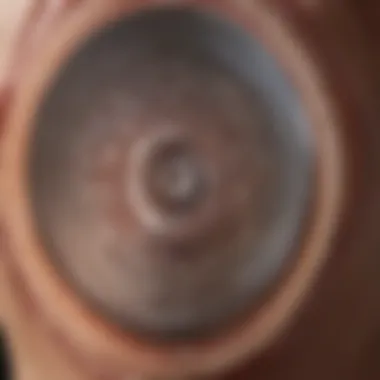
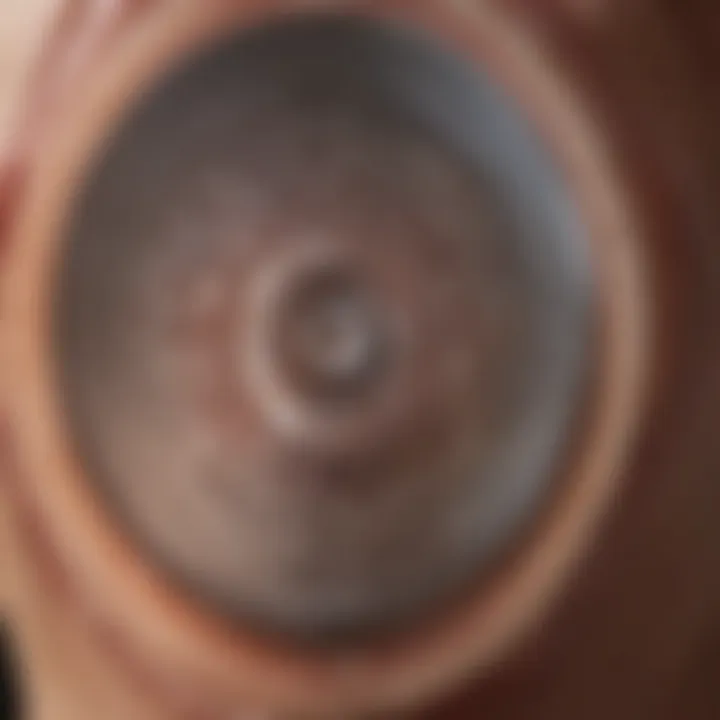
Intro
Learning about disc herniation is crucial for those in healthcare and patients alike. Disc herniation, while seemingly a technical term, refers to a fairly common ailment affecting many individuals. It involves the displacement of spinal disc material, which can affect the nerves and lead to significant discomfort. So why does it matter? Understanding the types of disc herniation can inform treatment decisions and better management strategies for patients experiencing back pain.
In this article, we will break down the various types of disc herniation, diving into definitions and mechanics. We will look at how symptoms can vary, diagnostic methods, and the available treatment options. Recognizing the type of herniation and its implications is critical for health professionals.
We will also touch on relevant anatomy that helps contextualize the discussion. Risk factors that predispose individuals to herniation will be evaluated, as they can provide insight into prevention. Lastly, advancements in treatments will be highlighted, ensuring that both professionals and patients are aware of current methodologies available in the healthcare landscape.
Let’s embark on this educational journey delving into disc herniation.
Preface to Disc Herniation
Disc herniation is a critical area in health discussions, pertinent for understanding the back pain epidemic affecting millions worldwide. Addressing this topic sheds light on the mechanical and biological aspects of spinal health, which directly impact a person's quality of life. Often overlooked until symptoms arise, knowledge about disc herniation can arm individuals with the information needed to seek prompt treatment, thus avoiding long-term consequences. This article aims to dissect the nuances of disc herniation, offering clarity on various forms one might encounter, and elucidating their implications on treatment and recovery.
Definition of Disc Herniation
Disc herniation, in simple terms, refers to the displacement of the intervertebral disc material beyond its normal confines. It happens when the soft nucleus of the disc bulges or breaks through the tougher exterior, which can cause pressure on nearby spinal nerves. To get a bit technical, herniation typically occurs in three stages:
- Degeneration: The disc loses hydration and elasticity, often due to aging or wear and tear.
- Prolapse: The nucleus pulposus pushes against the annulus fibrosus, causing it to bulge.
- Extrusion: At this stage, the inner material breaches the outer layer, which can lead to serious nerve compression and pain.
Understanding these phases is essential for recognizing the potential severity of herniated discs and their varied presentations in patients.
Understanding Spinal Anatomy
To fully appreciate disc herniation, one must grasp some fundamentals of spinal anatomy. The spine consists of several components that work harmoniously. Central to this is the intervertebral disc, acting as a shock absorber between the vertebrae. The disc is made up of two main parts:
- Nucleus Pulposus: This jelly-like core provides the cushion effect.
- Annulus Fibrosus: The tough outer layer that contains the inner core.
The spinal column itself is structured in three primary regions:
- Cervical (neck area): This uppermost section consists of seven vertebrae (C1-C7).
- Thoracic (mid-back): Twelve vertebrae (T1-T12) are attached to the ribs.
- Lumbar (lower back): This area houses five larger vertebrae (L1-L5) designed to bear loads.
When considering herniation, it's essential to note how these regions can be affected differently. For instance, issues in the lumbar region can lead to sciatica, while cervical herniation might cause numbness or weakness in the arms.
Given the intricate nature of spinal anatomy, even small changes can lead to discomfort or disability. Hence, diving deeper into this subject provides a pathway to understanding not just the mechanics, but the broader implications of disc-related issues.
Types of Disc Herniation
Understanding the types of disc herniation is fundamental for grasping the complexities of spinal health. Each type of herniation not only presents unique challenges but also demands tailored treatment strategies. With the spine being the backbone of human mobility and function, variations in disc herniation can significantly impact a person's quality of life. By dissecting the features of each herniation type, patients and healthcare professionals gain essential insights for effective management.
Cervical Disc Herniation
Cervical disc herniation occurs in the neck region and often leads to symptoms such as pain, numbness, or weakness extending down the arms. Understanding its occurrence is crucial as the cervical spine supports head movements while protecting the delicate spinal cord. The most commonly affected discs are C5-C6 and C6-C7.
One notable aspect is the way patients often describe their discomfort, as it can mimic other conditions. The pain might shoot down the arm as if it's a lightning bolt, often confusing the diagnosis. Importantly, conservative treatment options like physical therapy frequently yield positive results, allowing many individuals to avoid surgery. However, cases that persist may require surgical intervention, like a microdiscectomy, to relieve compression on nerves.
Thoracic Disc Herniation
Less common than cervical or lumbar herniations, thoracic disc herniation happens in the middle segment of the spine. This type can lead to unusual symptoms, as the thoracic region serves as a protective barrier for vital organs. Patients may experience pain around the rib cage or radiating sensations along the torso.
Thoracic herniations can be particularly tricky to diagnose because the symptoms may resemble cardia conditions. Hence, thorough evaluations are vital. Pain management often includes a combination of anti-inflammatory medications and physical rehabilitation. In severe instances, surgical options, like thoracotomy, might be necessary, but these should be carefully considered due to the complexity of the region.
Lumbar Disc Herniation
The lumbar spine, comprising the lower back, is commonly involved in disc herniations, causing a considerable amount of discomfort for individuals. Lumbar disc herniation can stem from degenerative changes or injuries and usually manifests as lower back pain radiating down the legs, known as sciatica.
What's interesting here is the demographic it predominantly affects. For instance, younger adults are often impacted due to heavy lifting or sports injuries, while older adults may suffer from gradual wear and tear. Recognizable techniques for dealing with lumbar herniations include physical therapy and targeted strengthening exercises, often leading to excellent outcomes. In situations where conservative measures fail, surgical options like laminectomy are considered to decompress nerve roots.
Cauda Equina Syndrome Herniation
Cauda Equina Syndrome is a rare but serious condition that arises from a herniated disc compressing the cauda equina, a bundle of nerves at the lower end of the spinal cord. This type of herniation requires immediate attention and is characterized by symptoms such as severe back pain, saddle anesthesia, and bowel or bladder dysfunction.
The gravity of this condition cannot be overstated; early intervention can make all the difference. The types of surgery performed in such urgent cases generally aim to relieve the pressure on the nerves, potentially restoring function before irreversible damage occurs.
In summation, each type of disc herniation carries its own set of implications and management strategies. Being aware of the unique characteristics and potential treatments can empower both patients and healthcare providers, fostering better outcomes.
Mechanisms Behind Disc Herniation
Understanding how disc herniation occurs is crucial for both treatment and prevention. The mechanisms that lead to herniation can shed light on its implications for patient care and management. By unpacking these mechanisms, medical professionals can devise more effective interventions and educate patients on minimizing their risk factors. Two primary culprits emerge: degenerative changes and traumatic injuries. These factors not only lead to herniation but also impact the severity of the condition and subsequent treatment options.
Degenerative Changes
Degenerative changes refer to the gradual wear and tear on the intervertebral discs, often a natural part of aging. The intervertebral discs are like cushions between the vertebrae; over time, they lose hydration, elasticity, and overall structural integrity. This decline is often referred to as disc degeneration.
Some specific elements related to degenerative changes include:
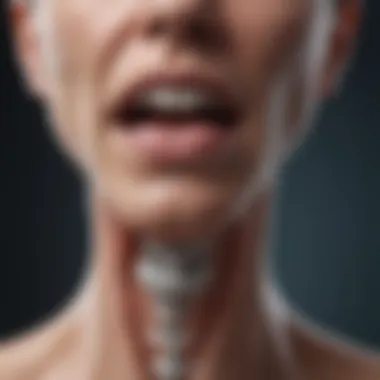
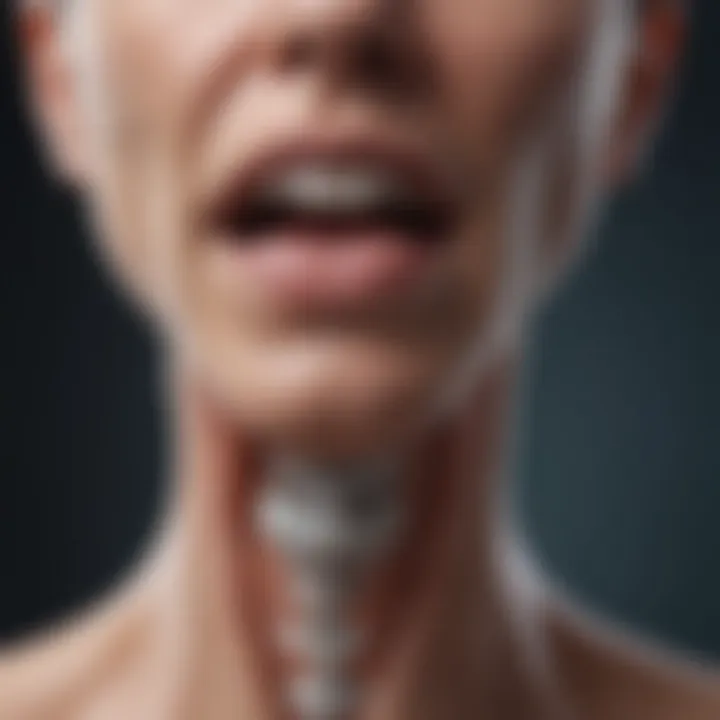
- Age: With each passing decade, discs tend to dry out, making them less resilient to stress.
- Genetic Factors: A familial predisposition to disc degeneration can play a role.
- Lifestyle Choices: Sedentary lifestyles can exacerbate degeneration, while maintaining a healthy weight through exercise can help mitigate risk.
The impact of these changes can be significant. A degenerated disc may bulge or rupture under pressure, pressing against spinal nerves and leading to a cascade of symptoms including pain, numbness, or weakness in nearby regions. Patients with these conditions often face a gradual decline rather than sudden symptoms, creating challenges in diagnosis and treatment. The nuance here is that not all degenerative changes lead to symptomatic herniation, so recognizing those at risk is vital. Consideration of lifestyle, genetics, and age can help tailor preventive strategies.
Traumatic Injuries
Unlike degnerative causes, traumatic injuries can lead to sudden onset and are often associated with specific events. These injuries can occur in various situations, such as:
- Sports Activities: High-impact sports can result in acute trauma.
- Car Accidents: Whiplash from collisions can put significant stress on the spine.
- Workplace Injuries: Heavy lifting or repetitive motions can also contribute.
Traumatic injuries often lead to immediate and observable symptoms, making diagnosis somewhat clearer. The mechanism here is usually related to excessive force or uncontrolled movement, causing the disc to bulge or protrude in an abnormal manner. This can create a reactionary pressure on surrounding nerves, leading to rapid pain and neurological symptoms.
A deeper understanding of these mechanisms allows healthcare providers to craft informed treatment plans and preventative measures. For instance, recognizing that a patient’s disc herniation stems from a past injury may influence rehabilitative strategies. Likewise, acknowledging degenerative changes might lead a practitioner to focus on lifestyle adjustments or conservative management before considering surgery.
In summary, both degenerative changes and traumatic injuries are pivotal in understanding disc herniation. Each mechanism has distinctive pathways and implications for patients, enriching clinicians' ability to address this common yet complex issue in spinal health.
Symptoms Associated with Disc Herniation
Understanding the symptoms linked to disc herniation is crucial for timely diagnosis and effective management. The manifestations of this condition can vary greatly depending on the type, severity, and location of the herniation. Being able to recognize these symptoms can lead to earlier medical intervention, potentially preventing further complications. Moreover, awareness of symptoms helps patients articulate their experiences to healthcare providers, facilitating a more accurate diagnosis.
Radicular Pain
Radicular pain is often one of the most tell-tale signs for individuals suffering from disc herniation. This sharp, shooting pain usually radiates along the path of a nerve that is being compressed or irritated by the herniated disc. For instance, a cervical disc herniation can cause pain that travels down the arm, while a lumbar disc herniation may result in pain that shoots down the leg.
Symptoms can be exacerbated by certain positions or activities, rendering everyday tasks challenging. Unlike generalized back pain, radicular pain has a distinct quality, often leading patients to describe it as a burning or tingling sensation. This symptom not only indicates nerve involvement but also highlights the need for focused medical evaluation.
Localized Back Pain
Localized back pain is another common symptom associated with disc herniation. This discomfort usually arises in the area where the herniation has occurred. Patients often report a dull ache or stiffness in the lower back, which can sometimes stem from muscle spasms as the body’s muscles attempt to stabilize the affected area.
This type of pain can vary in intensity and may worsen with movement, particularly bending or lifting. It's worth noting that localized back pain can sometimes be misleading; patients might think they have merely strained a muscle, while an underlying disc issue could be the root cause. Immediate attention to localized pain symptoms is essential, as it can lead to more serious complications if ignored.
Neurological Symptoms
Neurological symptoms represent a more severe consequence of disc herniation. They occur when pressure on the spinal cord or nerve roots leads to dysfunction in nerve pathways. Symptoms might include numbness, tingling, or weakness in the extremities. For example, individuals might find it difficult to hold objects or walk without a sense of instability if the nerves in their lower back are compromised.
In some cases, patients may also experience loss of bladder or bowel control, indicating a medical emergency called cauda equina syndrome. These neurological symptoms underline the importance of seeking prompt medical evaluation when symptoms of disc herniation arise. Ignoring these signs can lead to irreversible nerve damage and long-term disability.
Understanding these symptoms is essential for effective treatment and management of disc herniation. Being proactive can help mitigate complications and improve the quality of life for those affected.
In summary, awareness of symptoms associated with disc herniation is critical. Recognizing radicular pain, localized back pain, and various neurological symptoms not only assists in proper diagnosis but also significantly influences treatment options. Patients are best served when they are well-informed and empowered to communicate their experiences to healthcare providers.
Diagnostic Techniques
Understanding disc herniation necessitates a rigorous diagnostic approach. The techniques used in diagnosis play a pivotal role in determining the specific type of herniation, which influences the treatment pathway. An effective evaluation not only aids in identifying the extent of the condition but also helps tailor a management plan suited to individual needs.
Clinical Evaluation
The first step in the diagnostic process is often a thorough clinical evaluation. This involves taking a detailed medical history and conducting a physical examination. During the clinical evaluation, healthcare professionals typically assess the patient’s symptoms, lifestyle habits, and any previous injuries that could have contributed to the condition. This thorough assessment provides the groundwork for further diagnostic imaging if necessary.
Both subjective and objective methods are employed during this phase. Subjective methods involve discussing symptoms like pain intensity and frequency, while objective evaluations include motor and sensory tests. These elements together assist practitioners in understanding the condition's impact on the patient and deciding if imaging tests are warranted.
Imaging Studies
Imaging studies are integral for confirming a diagnosis of disc herniation. They allow for a visual examination of the spine and any abnormalities present. There are various imaging techniques that can be utilized, each serving a unique purpose and offering distinct advantages.
Magnetic Resonance Imaging
Magnetic Resonance Imaging (MRI) stands out due to its ability to provide detailed images of soft tissues, including intervertebral discs and nerves. Its non-invasive nature makes it a preferred choice in evaluating disc herniation. The key characteristic of MRI is its high-resolution images, enabling clinicians to assess the exact location and degree of the herniation.
One of the unique features of MRI is its capability to visualize both the affected disc and surrounding nerve structures, helping to determine if the herniation has impacted nearby nerves. Advantages include:
- No exposure to radiation.
- Ability to capture images in multiple planes.
- Detailed view of soft tissues.
However, MRI may have some drawbacks, like longer scanning times and higher costs compared to simpler imaging techniques.
Computed Tomography
Computed Tomography (CT) scans also serve an important diagnostic role, especially in patients who may not be able to undergo MRI. The key characteristic of CT imaging is its exceptional capacity for detailing bony structures. This makes it useful in diagnosing disc herniation while providing a comprehensive view of the spinal bony anatomy.
A unique feature of CT is its speed compared to MRI, which is beneficial in acute care scenarios. While CT might expose patients to radiation, its advantage lies in its ability to visualize specific structures that may not be as clearly seen on MRI. Some pros include:
- Faster procedure time.
- Better for assessing bone injuries.
However, it is worth noting that CT scans may not visualize soft tissues as well as MRIs, potentially missing subtle soft tissue abnormalities.
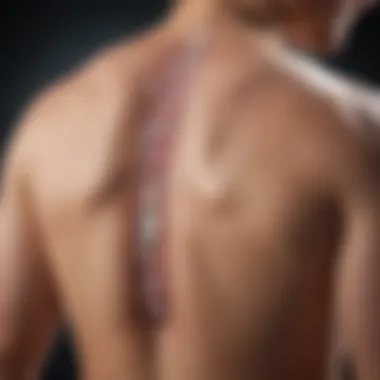

X-rays
X-rays are often the first imaging study conducted for spinal issues, providing a quick insight into spinal alignment and any gross bony abnormalities. The key characteristic of X-rays is their capacity to reveal structural deformities, thereby ruling out other issues before more advanced imaging is performed.
Their unique feature lies in the ability to easily assess changes in bone and joint structure. Major advantages include:
- Quick and widely available.
- Lower cost compared to MRI and CT.
However, X-rays do come with limitations. They do not provide comprehensive information on soft tissues, making them less effective for a definitive diagnosis of disc herniation alone.
In essence, each imaging technique offers unique strengths and weaknesses. Practitioners often employ a combination of evaluations to piece together a complete picture, allowing for highly informed clinical decisions regarding management and treatment with optimal outcomes in mind.
Treatment Approaches
In addressing disc herniation, the selection of appropriate treatment approaches is crucial. Understanding these methods enables both patients and practitioners to make informed decisions and to tailor management plans according to individual needs. The treatment landscape is diverse and spans from conservative techniques to more invasive surgical options. Each approach comes with its own benefits and considerations. Success in addressing herniation often hinges on early intervention and recognizing which method is best fit for the patient’s specific circumstances.
Conservative Management
Conservative management often kicks off the treatment plan when dealing with disc herniation. This phase is critical because it aims to alleviate symptoms while reducing the risk of progression and complications.
Physical Therapy
Physical therapy stands out as an essential part of conservative management for disc herniation. It serves as a comprehensive strategy to recover both function and strength. The key characteristic of physical therapy lies in its customized routines designed to improve flexibility, strength and restore normal movement patterns. For the patients dealing with pain and mobility issues, physical therapy can provide a gentle approach that does not rely on medications or invasive procedures.
A unique feature of this intervention includes individualized exercise programs. These tailored plans consider each patient’s specific condition and lifestyle. The advantages here are manifold; not only does it help in pain management, it also educates the patients on body mechanics to prevent future issues. However, it often requires commitment and consistency, and results are sometimes gradual, leaving patients in search of more immediate relief.
Medications
Medications also play a key role in managing disc herniation, particularly when dealing with inflammation and pain. OTC options, like ibuprofen or acetaminophen, can effectively reduce discomfort, allowing patients to engage in daily activities without significant hindrance. The accessibility and simplicity of medications make them a popular choice as patients can often manage their pain at home without clinical visits.
A unique aspect of medications is that they serve not only to alleviate pain but also to improve the overall quality of life during the recovery process. Despite their benefits, long-term reliance on medications can lead to complications, including potential side effects and dependency issues, which is why they often form part of a broader management plan rather than a stand-alone solution.
Lifestyle Modifications
Lifestyle modifications encompass adjustments that patients can make to enhance their overall well-being while dealing with disc herniation. They include practical changes, such as adopting ergonomic furniture, regular exercise, and proper lifting techniques. The central characteristic of these modifications is their empowerment aspect, as patients take control of their health through simple yet effective strategies.
This approach has advantages that are twofold: not only can it decrease the burden of symptoms, but it also promotes long-term health and potentially reduces the risk of future incidents. Patients can expect that meaningful changes in daily routines can lead to noticeable improvements over time. Nonetheless, lifestyle modifications may require substantial motivation and discipline, making it a longer-term strategy.
Surgical Intervention
On the other end of the spectrum, surgical interventions are often reserved for cases where conservative management fails or when significant neurological deficits arise. Surgical options aim to remove or repair the damaged disc, with procedures tailored to specific circumstances. Surgical methods can often lead to more rapid relief from debilitating pain, although they naturally come with higher risks and recovery timelines.
Microdiscectomy
Microdiscectomy is one focused type of surgery, often recommended when non-surgical options don't yield results. The hallmark of microdiscectomy is removing portions of the herniated disc that press on spinal nerves, thus alleviating pain. This procedure is minimally invasive, leading to shorter recovery times and less postoperative discomfort. Its popularity stems from a significant success rate in restoring mobility and quality of life. A unique feature is that patients generally experience relief soon after the procedure. However, it’s not without drawbacks, most notably the fact that surgery carries inherent risks, and not all patients may be suitable candidates.
Laminectomy
Then there’s laminectomy, which involves removing a part of the vertebra to create more space for the spinal cord and nerves. The key characteristic of this surgery is its broader application; it not only treats herniation but also conditions like spinal stenosis. Patients often find significant relief, making this a preferred option for complex cases. The unique feature of laminectomy is that it can provide immediate symptom relief as it directly addresses nerve compression. However, potential disadvantages include longer recovery times compared to microdiscectomy, alongside risks related to anesthesia and complications from surgery.
Artificial Disc Replacement
Artificial disc replacement offers another surgical pathway for patients with severe herniation. This method involves replacing the damaged disc with an artificial one, aiming to maintain normal spinal motion. The key characteristic is its potential to preserve mobility, standing in contrast with traditional fusion surgeries aimed solely at stabilizing the spine. With advancements in design and materials, artificial discs have shown promising outcomes for restoring functionality. A unique feature is its adaptability across different patient profiles, which makes it appealing for many undergoing surgery. Nonetheless, it’s important to note that as a newer technique, long-term data on outcomes and complications are still evolving, presenting some degree of uncertainty for both patients and surgeons.
Factors Influencing Disc Herniation
Understanding the factors that contribute to disc herniation is crucial for both prevention and treatment strategies. By recognizing these elements, patients and practitioners can tailor interventions to reduce the risk and enhance recovery outcomes. This exploration dives into how certain genetic predispositions and occupational risks can set the stage for disc-related complications, underscoring their significance in the discourse around spinal health.
Genetic Factors
Genetics play a pivotal role in determining who might be susceptible to disc herniation. Certain inherited traits make some individuals more prone to disc degeneration. Research suggests that inherited conditions affecting collagen or other connective tissues can predispose people to spinal issues.
For instance, a family history of herniated discs can hint at a likelihood of experiencing similar problems. Mutations in genes responsible for spinal structure maintenance may lead individuals to develop weak spots. These factors can compound the risks associated with lifestyle choices, resulting in premature wear and tear of the intervertebral discs.
Factors to consider:
- Family History: A history of herniation in close relatives increases risk.
- Collagen Disorders: Conditions like Ehlers-Danlos syndrome make tissues less resilient.
- Age-Related Changes: Genetic factors often manifest as we age, increasing susceptibility.
Occupational Risks
Work environment and activities significantly influence the likelihood of disc herniation. Certain jobs that require heavy lifting, prolonged sitting, or repetitive movements place additional stress on the spine, potentially leading to herniation over time. It's like trying to find a needle in a haystack—while the exact cause of herniation might remain elusive, the role of profession establishes a clearer path toward understanding and mitigating risks.
Jobs that often carry higher risks include:
- Construction Work: Lifting heavy materials can strain the back.
- Office Jobs: Long hours sitting can weaken muscle support for the spine.
- Drivers: Extended periods in the same position can stress spinal structures.


Considerations for managing these risks are essential for workers in high-risk occupations:
- Proper Ergonomics: Educating employees on correct posture and lifting techniques can promote spine health.
- Regular Breaks: Encouraging movement can alleviate stress accumulation in the back.
- Physical Fitness: Maintaining a strong core can support the spine and reduce strains.
"Recognizing the interactions between genetics and occupational demands helps tailor preventative strategies against disc herniation."
In summary, the influence of genetic predispositions and occupational hazards plays a vital role in the development of disc herniation. By identifying these unique factors, strategies can be devised to minimize risks and improve overall spinal health.
Complications of Untreated Disc Herniation
The topic of complications arising from untreated disc herniation is crucial for anyone grappling with spinal health issues. Understanding what can go wrong if these problems are left unaddressed serves as a wake-up call for individuals who may dismiss milder symptoms. When people overlook their discomfort or assume it will just go away, they can inadvertently invite a slew of complications that could transform a manageable situation into a chronic nightmare.
Being informed helps in making educated choices about seeking treatment, thus potentially avoiding irreversible damage to the spinal structure and function.
Chronic Pain Development
Chronic pain is, perhaps, one of the most debilitating consequences of not treating a herniated disc. Initially, the discomfort might be manageable, limited to sporadic flare-ups. However, over time, the continued pressure on nearby spinal nerves can lead to persistent pain that doesn't ease with over-the-counter medications.
At its worst, this pain can be unrelenting. It may manifest not just in the back but could radiate down the arms or legs, depending on which disc is herniated. Individuals might find themselves waking up in the middle of the night, unable to find a comfortable position, or struggling to perform even the simplest tasks during the day. This affects not only quality of life but can also bring about psychological issues such as anxiety and depression, creating a vicious cycle of discomfort and emotional turmoil.
"Ignoring the pain today could lead to years of suffering tomorrow."
Motor Function Impairment
The ramifications of untreated disc herniation are not merely about pain; they can extend to motor function impairment. When a herniated disc presses on the spinal cord or nerves, it can disrupt signals to various parts of the body. This situation may lead to significant challenges, ranging from mild coordination issues to outright loss of muscle strength.
Imagine an artist who suddenly finds it difficult to hold a paintbrush due to herniated discs in her back. Or consider a parent unable to lift their child without struggling; this could be the unfortunate reality for many. In severe scenarios, untreated herniation may culminate in conditions like drop foot, where an individual can't lift the front part of their foot, leading to tripping and falling.
Moreover, motor function impairments can hinder one's professional life, even making certain careers unmanageable. The restrictions created by motor dysfunction often necessitate lifestyle changes, further compounding the impact on mental and emotional wellbeing.
Research and Innovations
In the relentless pursuit of understanding and treating disc herniation, the domains of research and innovation stand as vital pillars. These fields not only aim to enhance existing treatments but also open up avenues for potential breakthroughs that could reshape patient care in significant ways. The importance of continued research cannot be overstated, as it lays the groundwork for new methodologies and technologies that can directly impact patient outcomes.
Scientific inquiry into disc herniation enables researchers to decipher the complex mechanisms that lead to its occurrence. Insights gained from such studies often translate into improved diagnostic methods and individualized treatments. Moreover, the evolving landscape of technology has birthed novel innovations that can potentially revolutionize how practitioners address disc disorders.
Regenerative Medicine in Treatment
Regenerative medicine has emerged as a beacon of hope for those grappling with the debilitating effects of disc herniation. This approach seeks to harness the body’s innate healing capabilities, offering a fresh perspective on how to repair and rejuvenate damaged tissues. One promising avenue of regenerative medicine is the use of stem cells, which can differentiate into various cell types that constitute spinal discs. This could lead to restoring lost functionality in affected individuals.
Another exciting trend in regenerative therapies is platelet-rich plasma (PRP) treatment. This involves concentrating the platelets from a patient's own blood and injecting them into the injured area. The growth factors in PRP can promote healing and potentially improve pain relief, allowing for enhanced recovery.
The convergence of cutting-edge science and clinical practice within regenerative medicine heralds a new era in the management of disc herniation, fostering hope for more effective treatments.
Research on Biomechanics
Understanding the biomechanics of the spine is crucial when addressing disc herniation. Research in this area focuses on how spinal movements, loads, and stresses contribute to disc degeneration and herniation. By employing advanced imaging techniques and computer simulations, researchers are able to study how different postures and activities affect spinal health.
Factors like improper lifting techniques, sustained poor posture, and repetitive strain can vastly impact the wear and tear on discs. Furthermore, the findings in biomechanics research inform rehabilitation protocols, guiding clinicians on how to prescribe safe and effective exercise regimens tailored to prevent further injury and enhance recovery.
In closure, research and innovations in both regenerative medicine and biomechanics extend far beyond academic interest; they hold the potential to fundamentally alter the narrative surrounding disc herniation treatments. Continued exploration in these fields is essential, paving the way for a future where management of this ailment is not only more effective but also emphasizes the preservation of spinal health.
Epilogue and Future Perspectives
The exploration of disc herniation offers significant insights into its types, underlying mechanisms, and treatment options. Understanding this condition is not just vital for healthcare professionals; it has implications for patients as well. Knowledge about disc herniation can empower individuals to recognize symptoms early, seek timely medical intervention, and make informed decisions regarding their health. Additionally, insights gleaned from this discussion contribute to patient management, ensuring a personalized approach to treatment.
From the current research, we find that disc herniation remains an area of active study, highlighting the necessity for ongoing investigation into innovative treatment modalities. As the landscape of medical science evolves, so does our understanding of disc-related issues and how best to address them. This article emphasizes the importance of integrating basic anatomical knowledge with clinical findings to optimize patient care.
"Proper understanding of disc herniation is crucial for effective diagnosis and treatment."
In summary, the various types of disc herniation reveal unique characteristics and implications for treatment pathways. This intricacy showcases why detailed studies are so crucial, ranging from identifying risk factors to personalizing intervention strategies. The insights gained from these discussions are essential for advancing our clinical practices and improving patient outcomes.
Summary of Findings
Through examining several forms of disc herniation, significant distinctions arise:
- Cervical, thoracic, and lumbar herniation all present different symptomatology and treatment challenges.
- The potential for cauda equina syndrome highlights the serious risks associated with untreated cases.
- The article also emphasized diagnostic techniques, including clinical evaluation and advanced imaging studies, as necessary tools for effectively identifying the condition.
Furthermore, complications that can arise from untreated herniated discs, such as chronic pain and motor function impairment, underscore the urgency for intervention. Thus, understanding these elements enhances the overall discourse on patient management.
Future Directions in Research
Going forward, research in the field of disc herniation should prioritize the following areas:
- Innovative treatment methods:
- Biomechanics studies:
- Patient-Centric Approaches:
- Exploration of regenerative medicine holds promise for non-invasive healing and pain relief.
- Development of new surgical techniques that minimize recovery time while maximizing effectiveness.
- Further understanding how daily activities contribute to the risk of herniation will help in preventative strategies.
- Investigating the relationships between lifestyle factors and degeneration can inform public health initiatives.
- Research that emphasizes personalized treatments based on genetic and occupational considerations may foster improved outcomes.
- Collaboration between healthcare professionals in multidisciplinary teams can lead to comprehensive management strategies.
Overall, focus on these aspects will pave the way for improved patient care and innovative solutions for those suffering from disc herniation.















